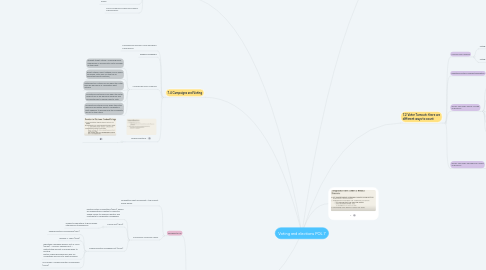
1. 7.3 Elections
1.1. Deciding to run
1.1.1. competitive seat=incumbent—the current office holder.
1.1.2. CAMPAIGN FINANCE LAWS
1.1.2.1. political action committees (PACs), which are organizations created to raise and spend money to influence politics and contribute to candidates’ campaigns.
1.1.2.2. Tillman Act (1907)
1.1.2.2.1. prohibit corporations to give money. intended for trasnparency
1.1.2.3. Federal Election Campaign Act (FECA)
1.1.2.3.1. Federal Election Commission (FEC)
1.1.2.3.2. Buckley v. Valeo (1976)
1.1.2.3.3. Bipartisan Campaign Reform Act of 2002 (BCRA) = McCain–Feingold Act = restricts the amount of money given to political parties, which had become a way for companies and PACs to exert influence
1.1.2.3.4. McConnell v. Federal Election Commission (2003)
1.2. NOMINATION STAGE
1.2.1. Primary
1.2.1.1. closed primary
1.2.1.1.1. only members of the political party selecting nominees may vote
1.2.1.2. open primary
1.2.1.2.1. allows all voters to vote
1.2.1.3. top-two primary,
1.2.1.3.1. pits all candidates against each other, regardless of party affiliation.
1.2.2. caucuses
1.2.2.1. A caucus is a meeting of party members in which nominees are selected informally.
1.2.2.2. delegates
1.2.2.2.1. delegates will bring state-level concerns and issues to the national convention for discussion,
1.2.2.2.2. local-level delegates bring concerns and issues to state-level conventions.
1.3. WHO IS ALLOWED TO REGISTER?
1.3.1. citizen, resident, and eighteen years old.
1.4. CONVENTION SEASON
1.4.1. last four to five days
1.4.2. covered by most news networks and cable programs.
1.4.3. helps the party nominee get positive attention while surrounded by loyal delegates, family members, friends, and colleagues.
1.5. GENERAL ELECTIONS AND ELECTION DAY
1.5.1. between mid-August and early November.
1.5.2. two major parties
1.6. THE ELECTORAL COLLEGE
1.6.1. The number of Electoral College votes granted to each state equals the total number of representatives and senators that state has in the U.S. Congress
1.6.1.1. winner-take-all system.
1.6.1.2. district system.
1.6.2. faithful party members
1.6.2.1. faithless electors unequal representation
1.7. MIDTERM ELECTIONS
2. 7.4 Campaigns and Voting
2.1. COMPARING PRIMARY AND GENERAL CAMPAIGNS
2.2. shadow campaigns
2.3. VOTER DECISION MAKING
2.3.1. straight-ticket voting—choosing every Republican or Democratic Party member on the ballot.
2.3.2. ballot fatigue. Ballot fatigue occurs when someone votes only for the top or important ballot positions,
2.3.3. Retrospective voting occurs when the voter base his decisions in candidate’s past actions.
2.3.4. Pocketbook voting occurs when the voter looks at his or her personal finances and circumstances to decide how to vote.
2.3.5. Prospective voting occurs when the voter applies information about a candidate’s past behavior to decide how the candidate will act in the future.
2.4. Federal elections
2.4.1. .
3. 7.5 Direct Democracy
3.1. referendum asks citizens to confirm or repeal a decision made by the government.
3.2. The most common form of direct democracy is the initiative, or proposition.
3.3. the recall is one of the more unusual forms of direct democracy; it allows voters to decide whether to remove a government official from office.
3.4. POLICYMAKING THROUGH DIRECT DEMOCRACY
4. Gerrymandering
5. How it works
6. .
7. 7.2 Voter Turnout= there are different ways to count
7.1. COUNTING VOTERS
7.1.1. voting-age population (VAP)
7.1.1.1. count people 18 and older even though some of these people are not eligible to vote
7.1.2. voting-eligible population (VEP),
7.1.2.1. citizens eighteen and older who are eligible to vote because they are citizens, mentally competent, and not imprisoned. more accurate but harder to count
7.2. registered voters=smallest population
7.2.1. Those who believe only informed and active citizens should vote point to the registered voter turnout numbers instead.
7.3. WHAT FACTORS DRIVE VOTER TURNOUT?
7.3.1. some target voting-eligible population who are not registered,
7.3.2. Most campaigns also target registered voters in general, because they are more likely to vote than unregistered citizens.
7.3.3. age=Those between eighteen and twenty-five are least likely to vote, while those sixty-five to seventy-four are most likely.
7.3.4. education and income
7.3.5. race
7.3.6. gender
7.3.6.1. after 1920 19 amendment gave women the right to vote. today women vote more than men.
7.4. WHAT FACTORS DECREASE VOTER TURNOUT?
7.4.1. the fact that is not mandatory
7.4.2. restrictions= ex. photo ID
7.4.2.1. Crawford v. Marion County Election Board (2008), =the Supreme Court decided that Indiana’s voter identification requirement was constitutional
7.4.2.2. Voting Rights Act’s preclearance list.
7.4.2.2.1. In Shelby County v. Holder (2013),
7.4.3. polling hours are only open on election day
7.4.3.1. polititians adress the problem: early voting, which opens polling places as much as two weeks early.
7.4.4. chronic minority.
7.4.4.1. ex. Republicans in California may stay at home because the mayority of voters are democrats so their vote would not impact.
7.4.5. voter fatigue.
8. 7.1 Voter Registration
8.1. VOTER REGISTRATION ACROSS THE UNITED STATES
8.1.1. state-by-state contests
8.1.1.1. president
8.1.1.2. statewide
8.1.1.2.1. different laws
8.2. HOW DOES SOMEONE REGISTER TO VOTE?
8.2.1. complete an application (except in North Dakota)
8.2.2. residency requirement (30 days)
8.2.2.1. College students, for example, may have to re-register or update addresses each year as they move.
8.2.2.2. The simple act of moving away to college presents a voter registration problem.
8.3. In 2002: Arizona first state to offer online voter registration.
8.4. Acts
8.4.1. Voting Rights Act (VRA) in 1965
8.4.1.1. The act protected the rights of minority voters by prohibiting state laws that denied voting rights based on race.
8.4.2. Twenty-Fourth Amendment in 1964 ended poll taxes,
8.4.3. Shelby County v. Holder (2013)
8.4.4. The National Voter Registration Act (1993),: make the process simpler
8.4.5. he Help America Vote Act of 2002 (HAVA)
8.5. WHO IS ALLOWED TO REGISTER?
8.5.1. citizen, resident, and eighteen years old= Some states have additional requirements.
